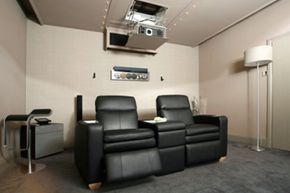While your home theater is still in the planning stages, choose the best bedroom for the conversion. Getting the acoustics right is important, so the layout of the room will be important, too. Choose a bedroom that's a simple rectangle. The fewer openings and protuberances there are the better. This means windows, doors, heat registers, exposed pipes, and features like bump-outs and built-ins.
Once you've chosen the space you'll be using, the next step is to tailor the space to fit the type of home theater system or media room you have in mind. For optimum viewing, home theater seating should be situated at least as far from the screen as double the screen's width to promote what video-equipment manufacturers call an immersive experience. So, if the screen is 60 inches wide, seating should be situated about 10 feet away (120 inches). You may be tempted to blow off this recommendation thinking bigger is always better, but if you place your theater seating too close to the screen, you risk being able to see the build-up structure of the image (the dots and groups of dots that make up the digital picture). If you're dealing with a small bedroom, you might have to curtail your dream of a huge screen because the available space is just too shallow.
These are some other things you should consider too:
- Are you more interested in a dedicated movie room, or will it also be used to play video games and music? The more components you add, the more space, electrical drain and compatibility issues you'll have.
- Will you need seating and furnishings to accommodate more than a couple of people? Distance from the screen and viewing angle (a minimum of 30-degrees) are both important. You may want to add a couple of rows of comfortable seating, but again, the overall depth of the room could be a problem.
- If you plan on installing soundproofing, do you want a relatively inexpensive option like acoustic wall tiles or panels, or a more involved and effective solution, like installing a layer of sound dampening material behind the walls?
- Do you want to automate processes like dimming the lights and closing the blinds? For a slick home theater experience, it's nice to do as much as possible with your trusty remote.
- Is the available electrical service adequate, or are there other rooms sharing power on the electrical circuit you plan to use? This can be a biggie, and it's better to deal with electrical issues sooner rather than later, even if you have to call in an electrician to do it.
- Do you intend to mount projection or other equipment on the walls or ceiling that will need additional electrical service or the installation of a heavy duty electrical box? This is another instance where having an electrician in the family (and being on good terms with one) can really pay off.
What you plan for the overall look of the room is important, too. If you're a DIYer who likes to tweak your equipment to get the best sound and picture, you may not mind piles of cables and cords lying around as long as you have easy access to the business end of your components. If you want your home theater to be a showplace, though, you'll probably feel more comfortable creating a wall of shelving for your equipment, or even a false wall that will make your screen look like a built-in while hiding some of the hardware and wiring from view.


